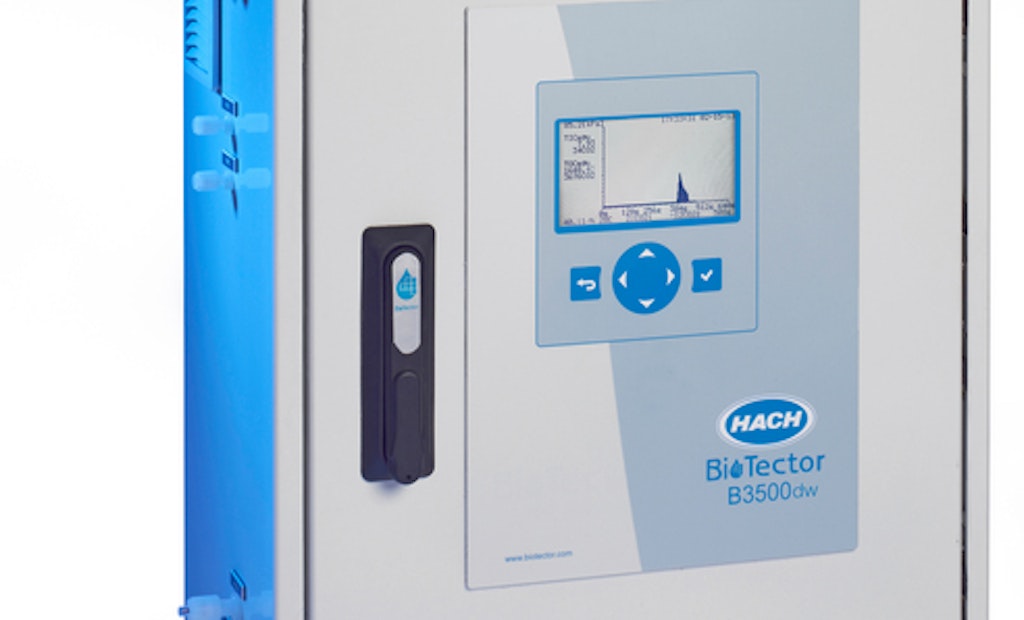Interested in Treatment?
Get Treatment articles, news and videos right in your inbox! Sign up now.
Treatment + Get AlertsReverse osmosis systems are highly effective for water treatment processes — especially when water quality must meet ultra-pure specifications. However, RO systems incorporate membranes and filters that are prone to fouling, scaling and biological overgrowth, which impedes the system’s efficiency and can lead to low water quality, fines and industrial process upsets due to the use of off-spec water.
Solution
By means of a reliable and online measurement method like Hach’s BioTector TOC analyzer at the end of the reverse osmosis process, the performance of the RO system is monitored, and the necessary alarm signals are triggered if an inconsistency is identified in the water stream. This allows water treatment plants to respond faster to quality issues and schedule maintenance before issues arise.
Benefits
For reverse osmosis applications, Hach offers a cost-effective option for low-range, clean-water TOC analysis. Hach’s BioTector TOC analyzers deliver reliable, accurate and online TOC data, providing an early warning of unusual water conditions within the reverse osmosis process. The BioTector is easy to operate, and only requires maintenance twice a year.
Background
Water treatment is required for a wide range of industries — both for the process of producing clean drinking water and clean water for a variety of industrial processes. These industries and applications include:
• Boiler feedwater
• Drinking water treatment
• Electronic industries
• Pharmaceutical manufacturing
• Food and beverage processing
• Effluent streams in wastewater treatment
• Process water for industrial manufacturing facilities
• Biotechnology industries
In each of these water treatment applications, the goal is to optimize production, while achieving the highest levels of quality and compliance, with a focus on product quality and output.
Reverse osmosis is one of many high-tech processes that deliver high-quality, clean water by removing contaminants. It is a preferred option, due to its affordability in comparison to other treatment methods. Reverse osmosis is employed to ensure a clean product stream to insert the treated water into a potable water supply or to meet ultra-pure water specification requirements in the industry.
In the reverse osmosis process, a semipermeable membrane is used to remove ions, molecules and larger particles from the water stream. It can remove many types of dissolved and suspended contaminants from water, including bacteria, and is used in both industrial processes and for treating potable water.
Reverse osmosis, however, comes with unique challenges. While reverse osmosis is an excellent choice to significantly reduce total dissolved solids, heavy metals, organic pollutants, viruses, bacteria and dissolved contaminants, the method can be prone to debris accumulation, chemical overload, biological overgrowth, organic fouling and membrane scaling. Unchecked, these potential issues can cause a treatment plant to face costly shutdowns or regulatory fines, or even lead to harm to humans and the environment. When the treated water is being used for various industrial processes, the end quality must be consistent and reliable, or the variable effluent could lead to process control and process inefficiencies.
To monitor and ensure the performance of the RO system and the water quality, water treatment plants can install TOC analyzers to monitor water at the start and at the final-stage of the reverse osmosis process, which helps to protect the reverse osmosis system, and to ensure quality of water with varying levels of TOCs.
Challenges with a reverse osmosis system
Reverse osmosis systems are used across many industries for clean water treatment due to their high removal rates for a wide range of contaminants. These systems also tend to operate efficiently, with low energy consumption. However, despite their widespread use and effectiveness, reserve osmosis systems tend to have problems. The membranes and carbon filters in reverse osmosis systems can experience accumulation of bacterial biofilms, scaling and solid impurities, which hinders the system from performing at optimum levels.
These potential problems can lead to serious implications for the end-product water. For many applications, the filtered, reclaimed water must conform to very strict purity requirements. These include water that is used for low and high-pressure boilers, irrigation, pharmaceutical manufacturing, and for food and beverage processing.
Water that is being re-injected into potable water supplies is also an area where the removal of organic contaminants is of great concern. While reverse osmosis is quite good at rejecting TOCs, some small organic molecules like pharmaceuticals, pesticides and carcinogenic compounds are not as reliably rejected.
When the efficiency of the reverse osmosis system degrades, the quality of the produced water declines. When this happens, the producer of the treated water can be faced with fines resulting from noncompliance, or can even be responsible for environmental hazards or human endangerment.
Using Hach’s BioTector for TOC analysis
Hach’s BioTector TOC analyzer monitors the purified water stream for signs of contaminants, so as the membranes and filters of the reverse osmosis system begin to degrade and permit organic molecules through the barrier, the problem can be identified and corrected immediately, before it escalates into unplanned downtime or process issues relating to poor water quality. The BioTector TOC analyzer incorporates the patented Two-Stage Advanced Oxidation technology to deliver highly reliable measurement and accurate data. This unique process passes oxygen through an ozone generator and combines the ozone with sodium hydroxide to form hydroxyl radicals. The hydroxyl radicals are used in the oxidation process to convert organic carbon in the sample to carbonate and oxalate.
First the sample is acidified and purged (sparged) with a carrier gas to remove inorganic carbon in the form of CO2. Then the sample is mixed with a base (sodium hydroxide) and ozone. The ozone reacts with the base (hydroxide ions) forming hydroxyl radicals. The hydroxyl radicals oxidize the sample into carbonate and oxalate. This is the first stage of the two-stage advanced oxidation process. Acid is again added to the sample. Next the ozone oxidizes the manganese contained in the acid. The oxidized manganese reacts with the oxalate formed during the first stage oxidation to produce CO2. This is the second stage of the two-stage advanced oxidation process. At the same time, the acid reacts with the carbonate formed during the base oxidation to also produce CO2 gas. An NDIR detector measures the concentration of CO2, which is proportional to the concentration of the TOC in the sample.
Benefits of a Hach BioTector
Hach’s BioTector TOC analyzer is a reliable system to measure and detect the presence of organics in a water stream. Because the BioTector analyzes samples reliably and provides online data, it is possible to identify when the performance of a reverse osmosis system may be impaired. For reverse osmosis applications, Hach offers a low-cost option for low-range TOC analysis with reliable and accurate performance. By means of an online BioTector analyzer, any process incidents or contaminant breakthrough in the reverse osmosis system are detected without delay, and an alarm is triggered automatically.
The BioTector TOC analyzer features:
• Accuracy of ±3 percent of reading
• MCert certified 99.86 percent uptime
• Low maintenance requirements (twice a year)
• No calibration requirements between services
• Self-cleaning technology
• Low cost of ownership
• Easy to operate
• Rapid payback on investment
• Patented Two-Stage Advanced Oxidation Technology
• Hazardous and nonhazardous area options
Using a reverse osmosis system for water treatment is a highly efficient and cost-effective solution to meet clean water requirements. However, reverse osmosis filters and membranes are prone to performance issues. Hach’s BioTector TOC analyzer helps to safeguard the water treatment process by monitoring the reverse osmosis water to ensure that it is free from organic contaminants, which might indicate a larger problem in the process. Using the internationally proven and patented Two State Advanced Oxidation technology, the BioTector TOC analyzer delivers maximum uptime, reliability and accuracy to ensure that the water quality requirements are met. And, with the analyzer requiring maintenance only twice a year for standard items like pump tube replacement, and calibration, it is also an affordable TOC analyzer with low cost of ownership.
For more information, visit www.hach.com.






